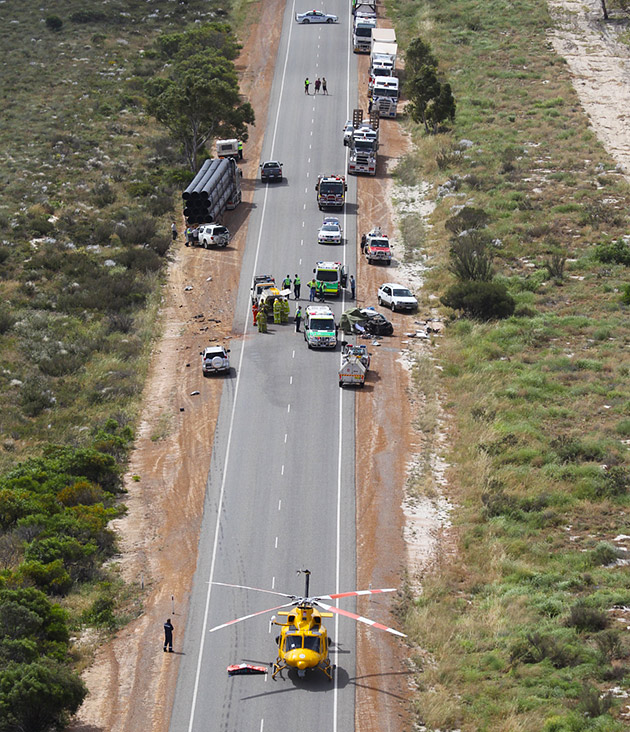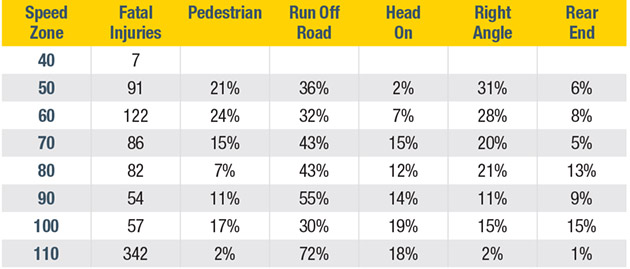15 May, 2019 By: Rebecca Martin
Even though speed is recognised as a leading cause of road fatalities, most people are against any targeted reductions to speed limits
Back in 2017, a six-year-old boy, his mother and an 83-year-old grandfather were killed in a head-on collision on the Indian Ocean Drive.
They were just three of six people killed on that notorious coastal corridor that year, a pretty but fatal road, with sweeping ocean views, scrubby native bush and an indiscriminate nature.
Mothers, fathers, grandparents, tourists, locals – the Indian Ocean Drive toll has been far reaching.
By the time that six-year-old boy tragically lost his life in 2017, a wide-reaching safety review of the Indian Ocean Drive was already underway, sadly too late to save him.
Experts found several levers to improve the safety of the Drive, including widening lanes, improved road markings, more overtaking lanes and at least immediately, a reduction in the speed limit from 110km to 100km on the road between Breakwater Drive and Lancelin, to lessen the trauma impact when crashes occurred.

Given the horrific road toll, the review, which included the Road Safety Commission, Main Roads WA and WA Police, was widely welcomed.
But the speed limit reduction drew condemnation and many inches of heated online discussion, even though best estimates suggested only three minutes would be added to the journey.
However, since that specific stretch of road was rezoned to 100km, there have been crashes, but no fatalities.
Speed resistance
The example shows that, even in the face of an unacceptable road toll on a road widely recognised as dangerous, speed and speed limits remain highly contentious for West Australians.
Even though speed is a leading cause of road fatalities and increases the chances of trauma in the event of a crash, most are against any targeted reductions to speed limits. Result from an RAC survey into attitudes to speeding showed the majority of WA motorists felt a low level of speeding was 'socially acceptable.'

“As a rule of thumb, a 10 per cent decrease in speed will result in a 40 per cent decrease in fatalities, regardless of the cause of the crash,” says Pat Walker, RAC executive general manager advocacy and members.
“But getting the WA community to support speed reduction is difficult. It’s not a silver bullet. Safer cars, safer drivers and better roads – all of that is critical. But the slower you are driving, the more chance you have of getting out alive from a crash, no matter the cause.”
Speed and the body
On the Indian Ocean Drive, the safety review found that a significant number of the crashes occurred from increased traffic, “resulting in vehicles drifting to the right and colliding with an oncoming vehicle.”
RAC Rescue helicopter critical care paramedic Eric Beason says he has attended “maybe a dozen crash situations” on the Indian Ocean Drive.

“People can’t judge distance very well when standing still, let alone at 110km an hour and with another object travelling at speed in the opposite direction
“Your depth perception is not made to translate what’s happening at that speed.
“When two cars impact at speed on a road like that, you get what we call a triple collision. There is the car impact, then your body hits something inside the car. Then inside your body, when your organs hit the inside of the car that’s where the real damage is done.
“You can’t always see that immediately, but the surgeons can see the difference in damage to the organs of someone injured at 110km versus one at 50km. So, it’s not a piece of metal that kills you it’s the impact of your organs against your body.
“The statistics don’t lie. Once you start bringing the speed down, the statistics go down. It doesn’t mean those roads aren’t safe, but it’s risk versus reward really. What kind of quality of life do you want and what risks are you willing to take to pay for that?”
Enjoying this article?
Sign up to our monthly enews
What do our members say?
A recent RAC survey found that unprompted, one in two members said speeding was one of the riskiest behaviours on our roads that leads to fatalities.
But there was little support from those survyed for a decrease in current speed limits, particularly on regional roads, where speed limits, and the fatality rates, are much higher.
However, after being presented with information about the impact of speed on survival rates, more than 25 per cent changed their minds.
“We think perhaps there is a disconnect in people’s minds as to how big a difference lower speed can make to your survival outcomes,” Walker says. “More education around that could help.”
Although four in five people said they focused more on obeying the road rules than arriving at their destination quickly, nearly all admitted to speeding on at least one occasion in the previous 12 months.
“It’s pretty concerning that so many people think it’s socially acceptable to drive over the speed limit, and do so regularly, yet also understand that in doing so, they’re increasing the risk for themselves and others on the road,” say Walker.
“For the hundreds of families that have been affected by road trauma and speed, that must be hard to understand.”

From 2013 to 2017, statistics from Main Roads WA show the number of fatalities are significantly higher on roads with a 110km/h limit, despite most of those roads being in regional areas with significantly less traffic.
Do it for the kids
One area where at least some members said reductions in speed limits was suitable was in school zones. Six in 10 were either supportive or neutral towards speed limit reduction in school zones and 28 per cent supported further speed reductions in built-up areas.
It’s a sentiment shared by the community in the City of Vincent.
Following a community survey which showed nearly 60 per cent support, a two-year trial is now underway reducing speed limits in some City of Vincent residential streets from 50km/h to 40km/h.
It’s hoped that the trial will reduce the severity of impact and injuries, if crashes occur, and create more liveable communities.
For more information on the trial visit imagine.vincent.wa.gov.au
We're working for safer roads
As part of RAC's commitment to reducing vehicle fatalities on our roads, we want all national highways upgraded to a higher safety rating and all new roads to be built to at least a 4-star standard.
